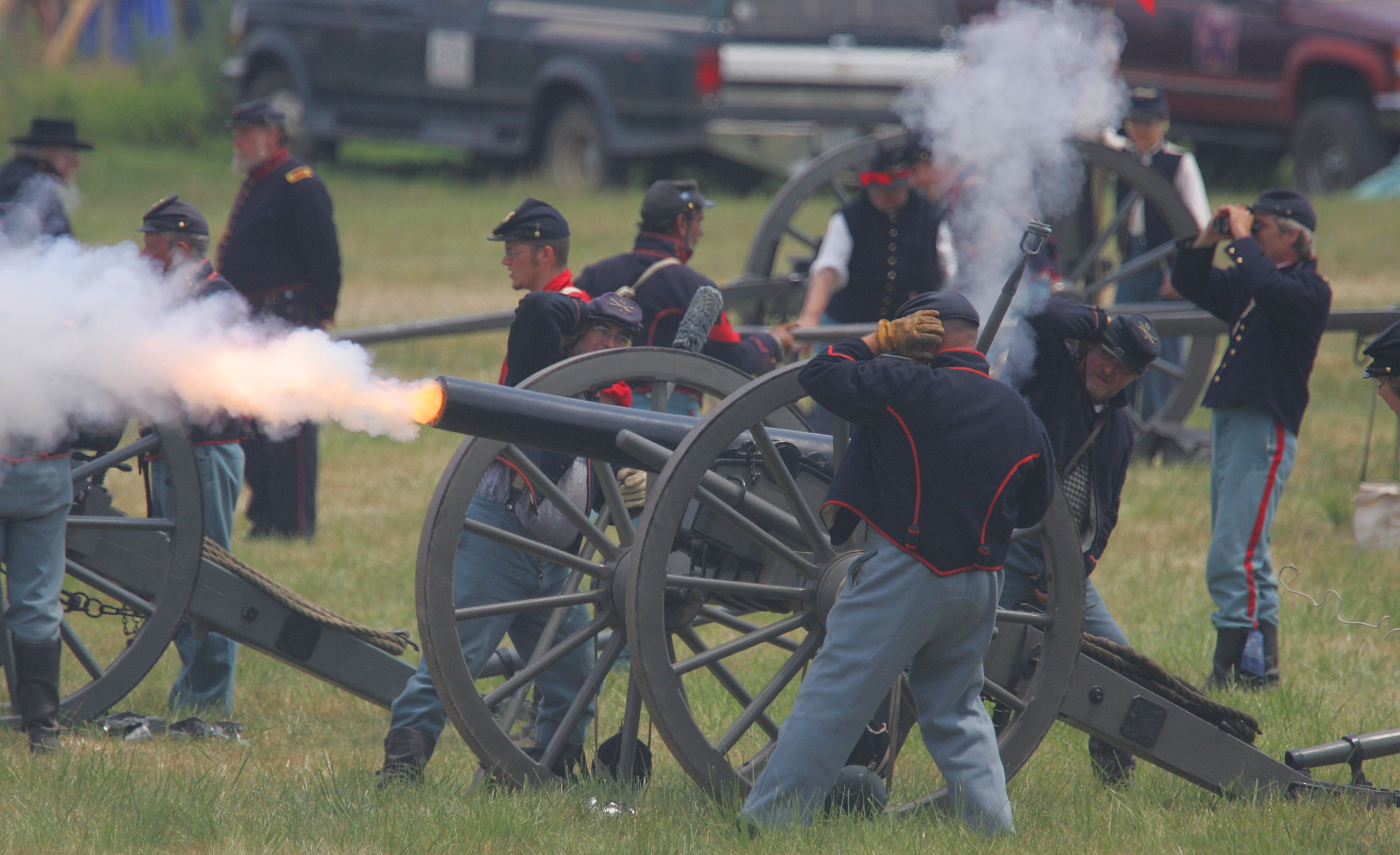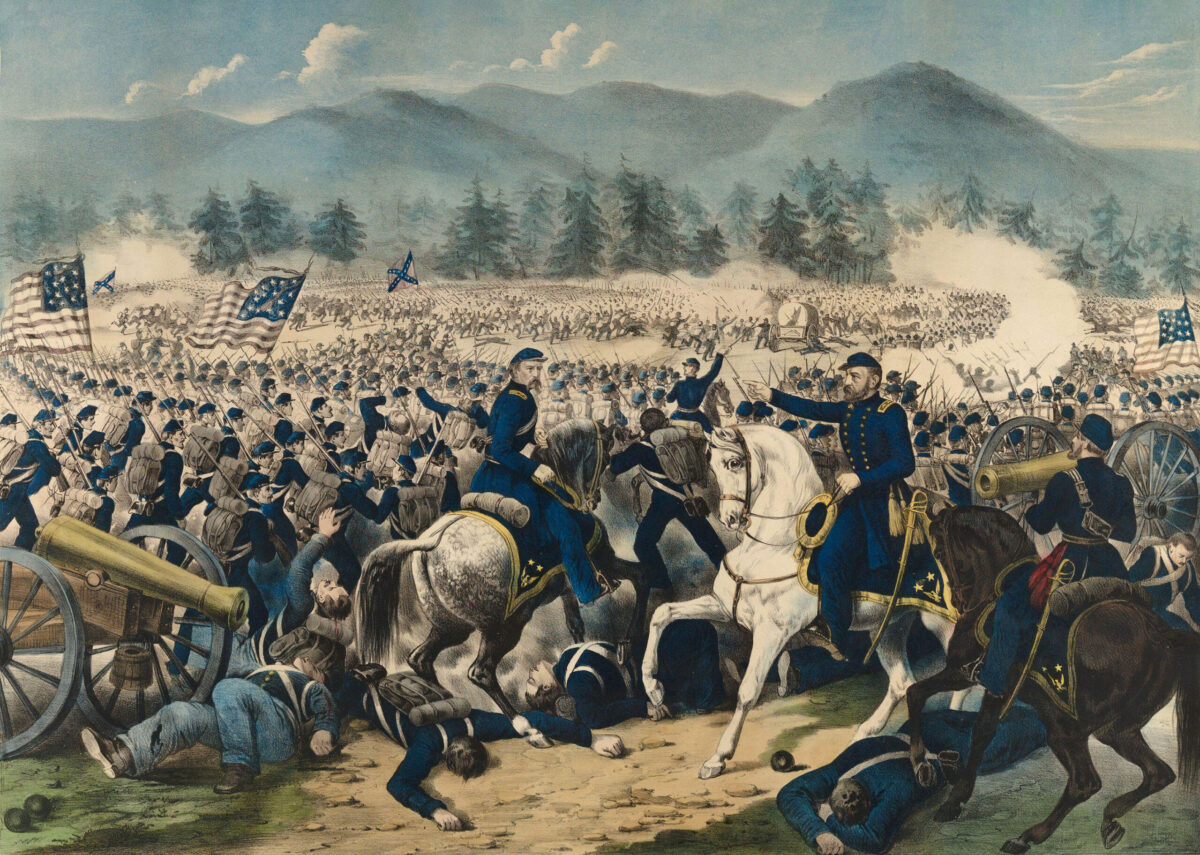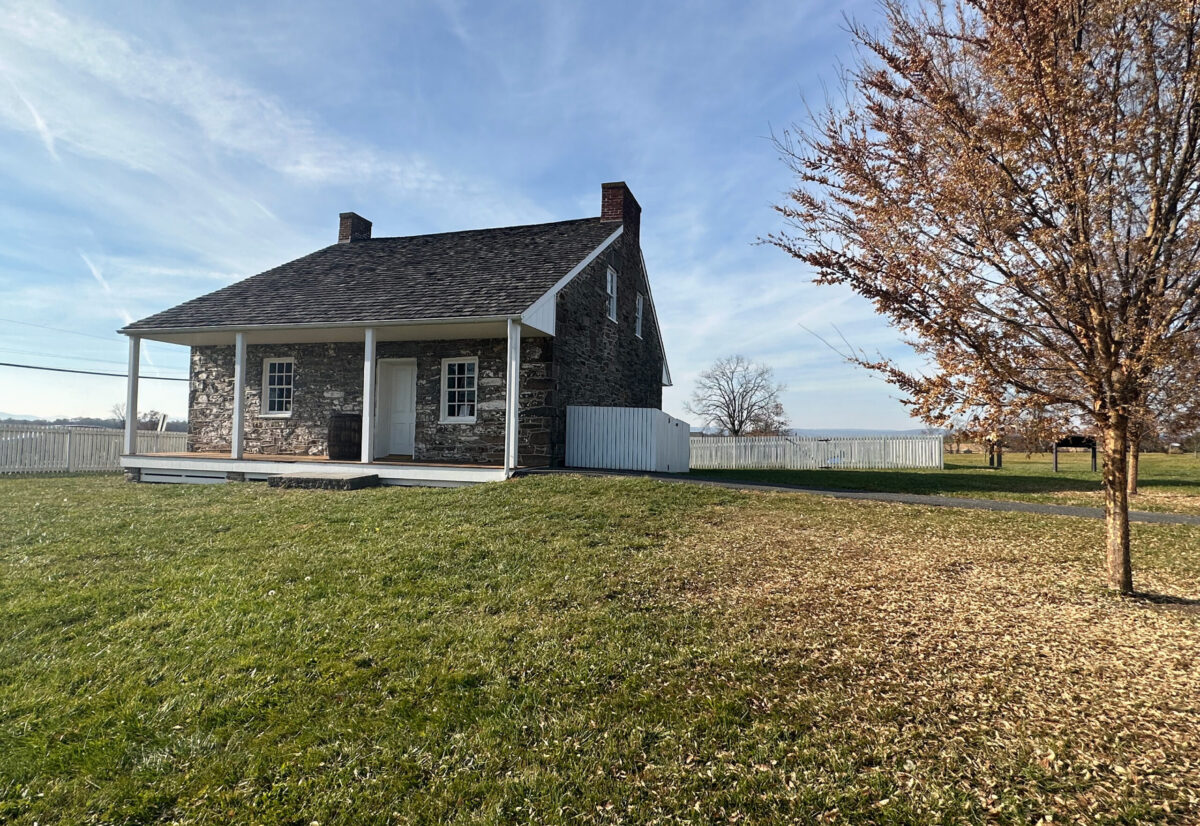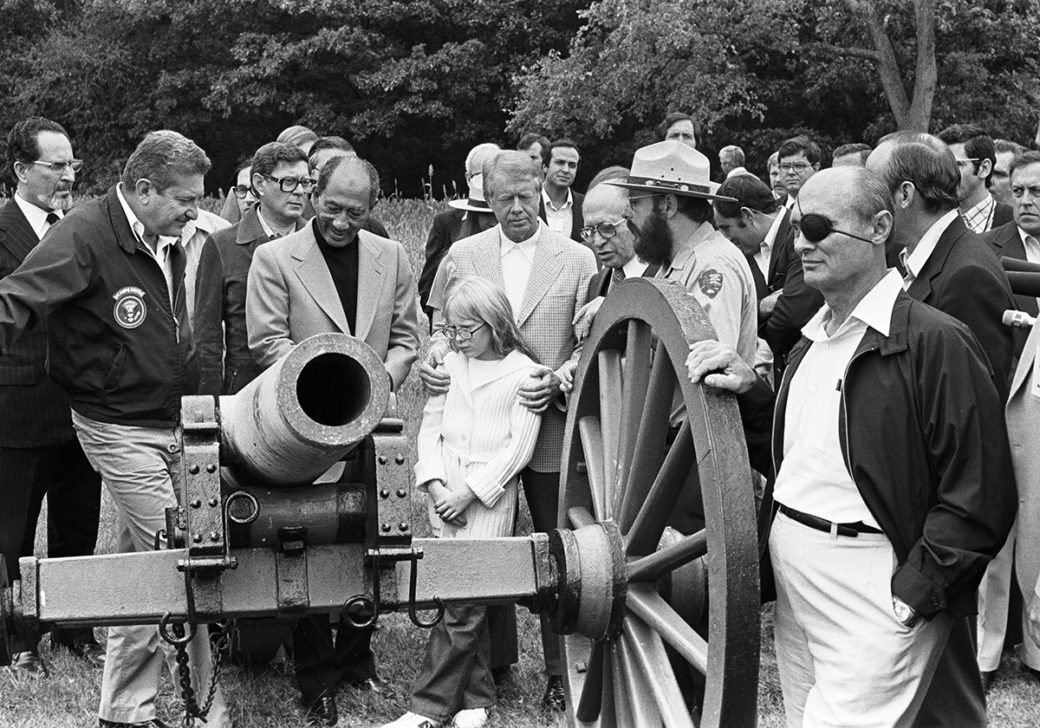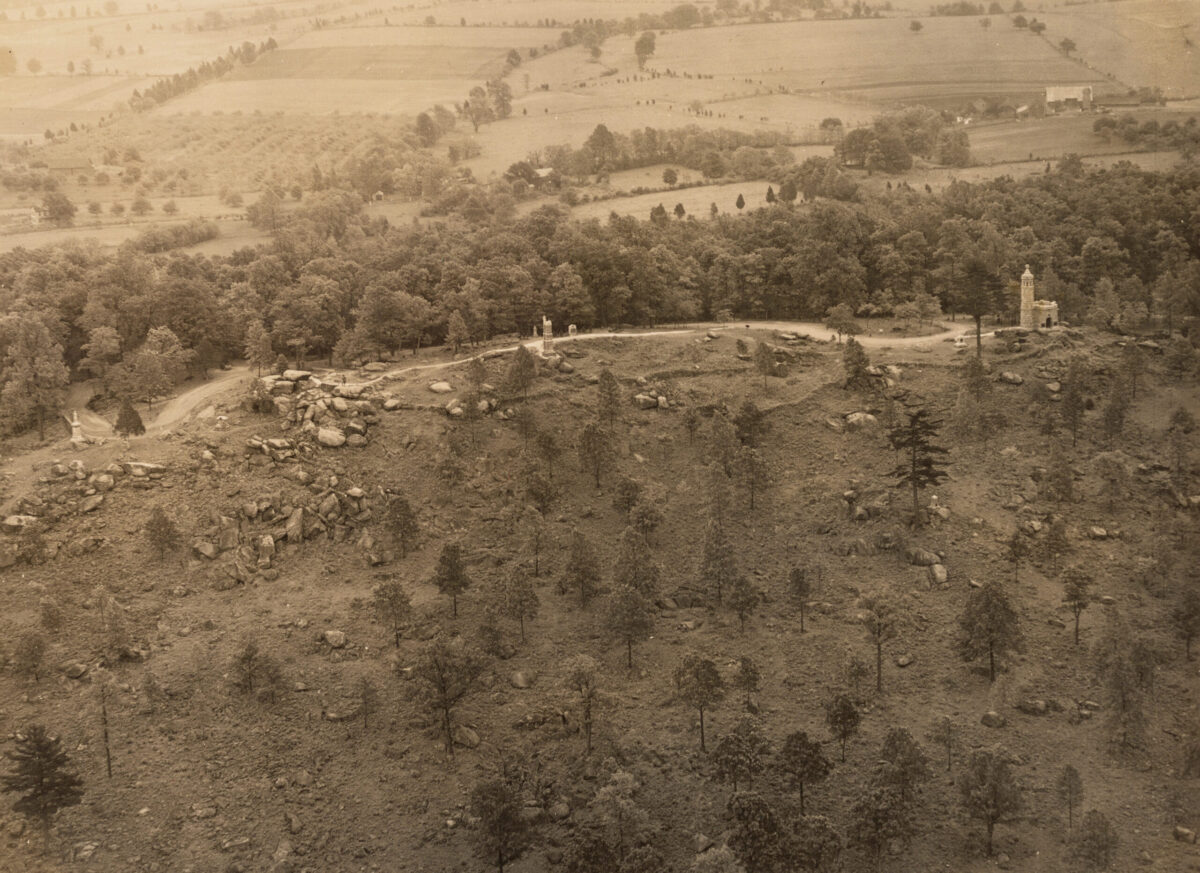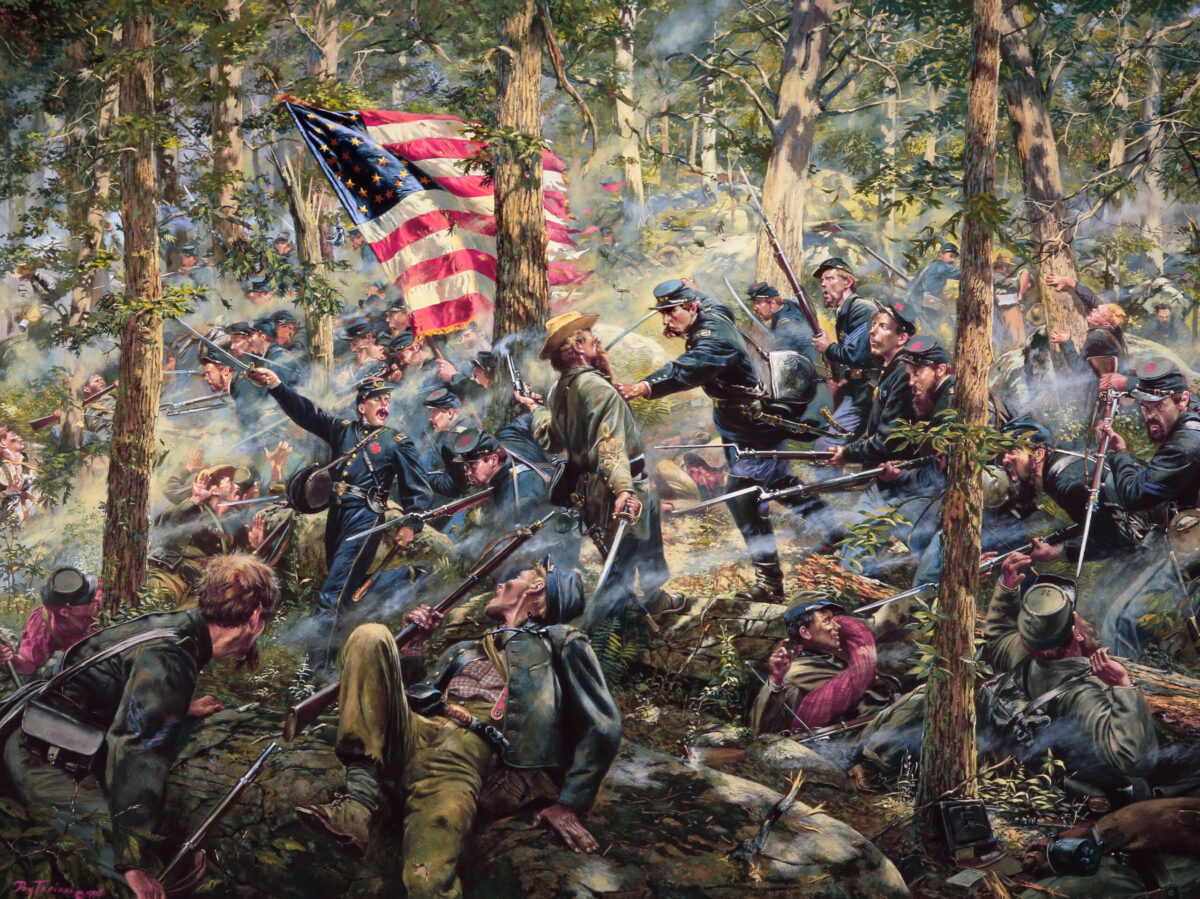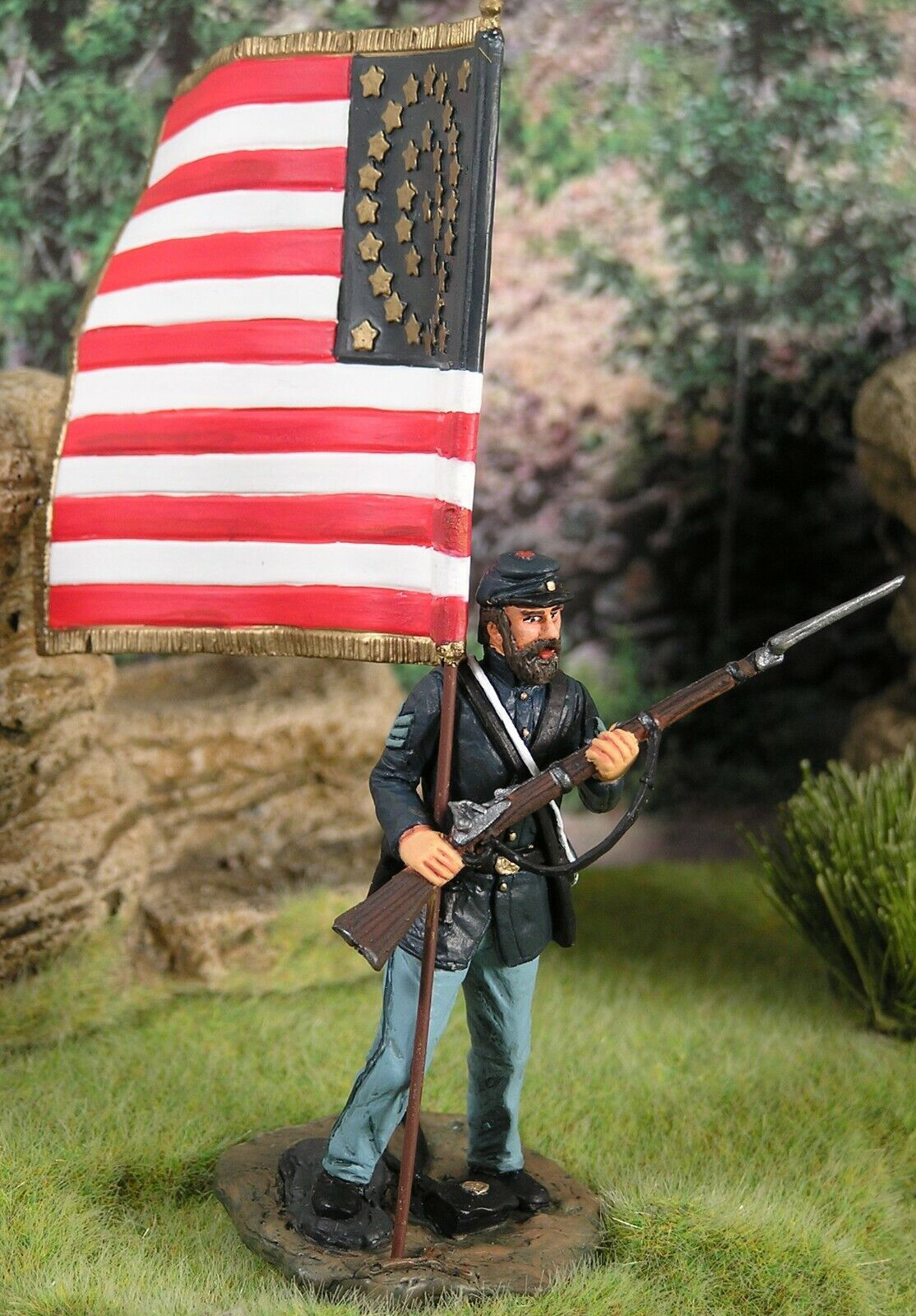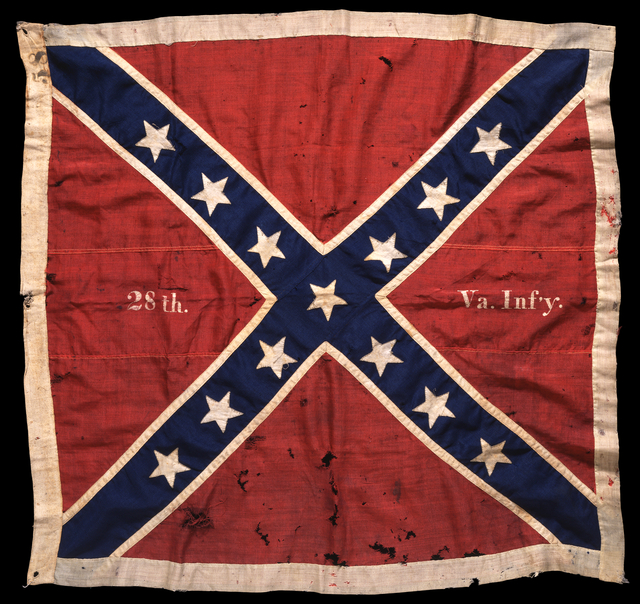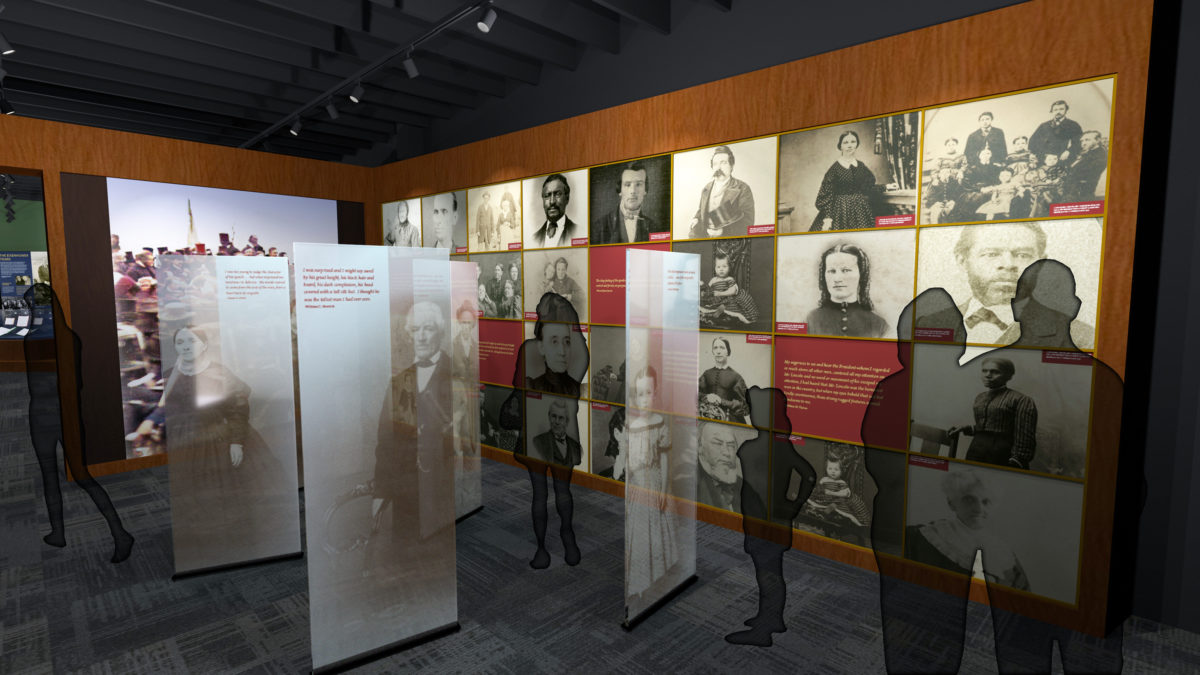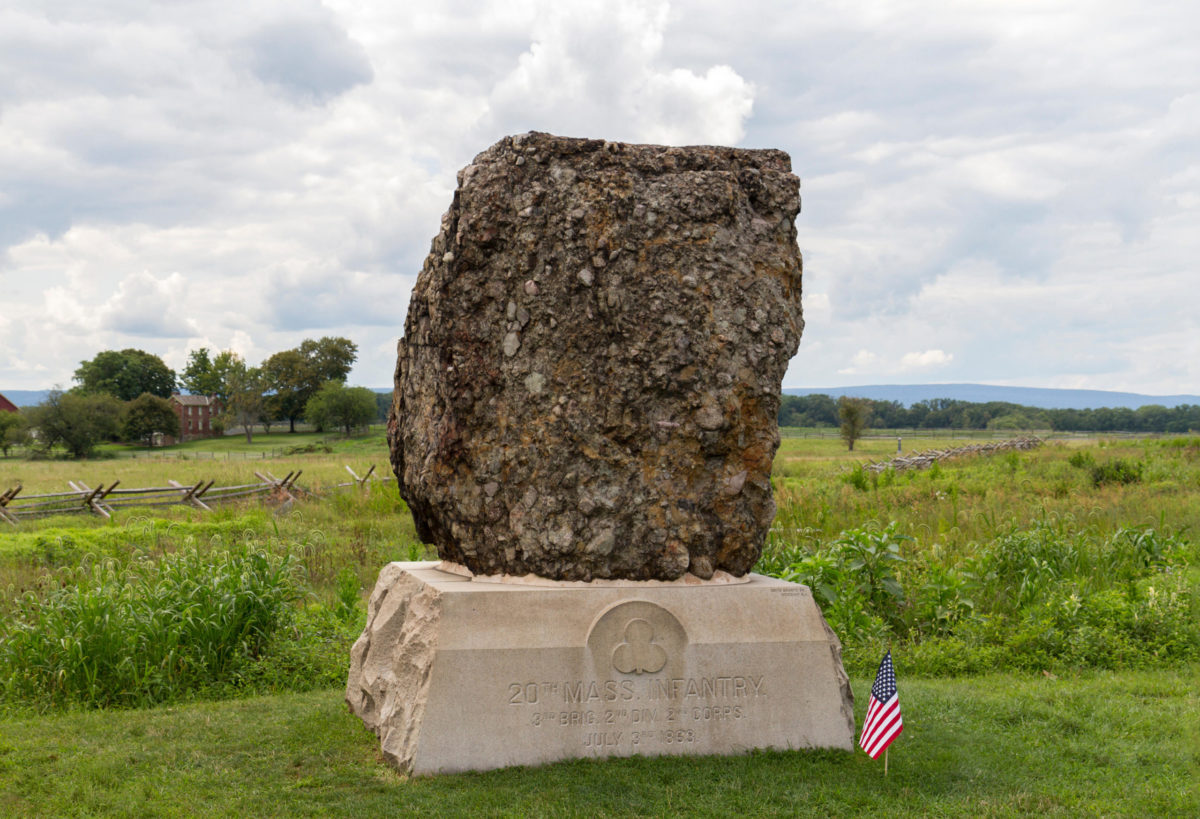The Battle of Gettysburg, Pennsylvania (July 1–3, 1863) was the largest battle of the American Civil War as well as the largest battle ever fought in North America, involving around 85,000 men in the Union’s Army of the Potomac under Major General George Gordon Meade and approximately 75,000 in the Confederacy’s Army of Northern Virginia, commanded by General Robert Edward Lee. Casualties at Gettysburg totaled 23,049 for the Union (3,155 dead, 14,529 wounded, 5,365 missing). Confederate casualties were 28,063 (3,903 dead, 18,735 injured, and 5,425 missing), more than a third of Lee’s army.
These largely irreplaceable losses to the South’s largest army, combined with the Confederate surrender of Vicksburg, Mississippi, on July 4, marked what is widely regarded as a turning point—perhaps the turning point—in the Civil War, although the conflict would continue for nearly two more years and witness several more major battles, including Chickamauga, Spotsylvania Courthouse, Monocacy, Nashville, etc.
Facts
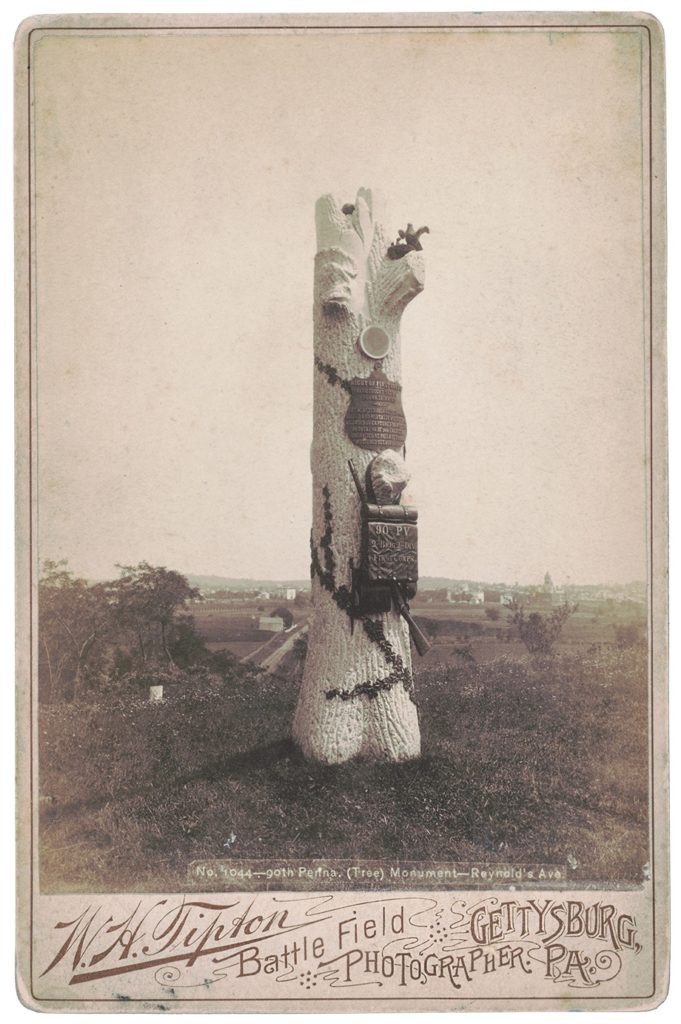
A Note on Military Ranks
Ranks shown for regular army Union officers at the Battle of Gettysburg are their ranks as commanders of U.S. Volunteers; their ranks in the U. S. Army were usually lower. Meade, for example, was a Major General of United States Volunteers (USV) but only a brigadier general in the regular army when he was placed in charge of the Army of the Potomac. “Old Snapping Turtle,” as he was called, was brusque with subordinates and superiors alike and would not be promoted to major general in the regular army until August 18, 1864.
Gettysburg Resources
when was the battle of gettysburg?
The Battle of Gettysburg took place July 1–3, 1863.
where is gettysburg?
Gettysburg is in Pennsylvania, in Adams County.
who led the armies?
Union General: George G. Meade
Confederate General: Robert E. Lee
how many soldiers fought at gettysburg?
Union Army: 82,289
Confederate Army: 75,000
how many people died in the battle of gettysburg?
- There were 23,049 Union casualties: 3,155 dead, 14,529 wounded, 5,365 missing.
- There were 28,063 Confederate casualties: 3,903 dead, 18,735 injured, 5,425 missing.
who won the battle of gettysburg?
It was a Union victory.
How Much ammunition was used?
An estimated 569 tons of ammunition was fired during the three days of fighting.
major Events & Figures
our latest gettysburg stories
The Gettysburg Campaign
In the wake of Confederate victory at Chancellorsville, Virginia (May 1–4, 1863), Lee decided to attempt a second invasion of the North. This would take pressure off Virginia’s farms during the growing season, especially in the “breadbasket of the Confederacy,” the Shenandoah Valley. Additionally, any victories won on Northern soil would put political pressure on Abraham Lincoln’s administration to negotiate a settlement to the war, or might lead to the South’s long hoped-for military alliance with England and France.
The campaign began under a dark shadow: Lee’s creative and aggressive corps commander, Lieutenant General Thomas “Stonewall” Jackson, had been mortally wounded by his own men at Chancellorsville. The Army of Northern Virginia reorganized from two corps to three, with Lt. Gen. Richard “Dick” Ewell replacing Jackson in the Second Corps and Lt. Gen. Ambrose Powell (A. P.) Hill commanding the newly formed Third Corps. Lieutenant General James Longstreet—Lee’s “Old War Horse”—retained command of the First Corps. The Army of Northern Virginia was about to invade enemy territory with two of its three corps commanders newly appointed to their positions, and the secretive, self-reliant Jackson had done little to prepare them for this level of command.
This would be Lee’s second incursion into the North. The previous one ended in the bloodiest single day in America’s history, the Battle of Antietam (called the Battle of Sharpsburg in the South) in Maryland on September 17, 1862. Total casualties from that one-day battle exceeded 23,000.
In order to mask the army’s movement up the Shenandoah Valley into western Maryland and central Pennsylvania, Lee depended upon his renowned cavalry leader J.E.B. “Jeb” Stuart. Upon crossing into Maryland, Stuart loosely interpreted Lee’s ambiguous orders and began raiding Union supply trains. Cut off by the advancing Army of the Potomac, from June 25 until the night of July 2, Stuart lost all communication with the rest of the Confederate army, leaving Lee to operate blindly deep in enemy territory.
Meanwhile, on the Union side, the Army of the Potomac was still under the command of General Joe Hooker, who had lost the Chancellorsville battle, diminishing his reputation as “Fighting Joe.” As reports arrived that the Confederates had crossed the Potomac and were on Northern soil, Hooker dispersed his army widely, trying to simultaneously protect the approaches to Washington, Philadelphia and Baltimore. He’d lost Lincoln’s confidence, and the president made the difficult choice to replace an army commander in the face of an enemy invasion. On June 28, a military engineer, Maj. Gen. George Gordon Meade—who had only been promoted to corps command less than six months earlier—was placed in charge of the Union’s largest army. He immediately ordered his scattered corps to concentrate in a manner that would allow each to be quickly reinforced by another. He hoped to draw Lee into attacking him on high ground along Pipe Steam Creek.
As Meade’s corps moved closer to each other, Lee’s army was scattered, moving along multiple roads. He issued orders to his subordinates to not bring on a general engagement until the army could concentrate its forces. Fate had other plans.
Day 1
On the morning of July 1, Major General Henry Heth, of A.P. Hill’s Third Corps, sent his 7,500-man division down the Chambersburg Pike toward Gettysburg. Encountering resistance, they initially assumed it was more of the hastily assembled Pennsylvania Emergency Militia that they’d been skirmishing with during the campaign.
In reality, Colonel John Buford had deployed part of two brigades of Union cavalry as skirmishers in the brush along Willoughby’s Run three miles west of town. Just two weeks previously, they’d been issued breech-loading carbines, and they used the guns’ fast-loading capability to create the impression of a much larger force, slowing the advance of Hill’s brigades for a time before falling back.
notable facts
- John Buford, whose cavalry fired the first shots of the battle, died December 16, 1863. His death is thought to have resulted from typhoid fever and a body weakened by exhaustion. He received a deathbed promotion to major general, post-dated to July 1, 1863.
- During the battle, a random bullet went through the door of a house, striking and killing 20-year-old Mary Virginia (Jenny) Wade. She was the only civilian killed during the battle.
The Confederates followed them across the stream, only to meet a line of Union infantry on McPherson’s Ridge. The Army of the Potomac was arriving piecemeal, and among the first to arrive was a brigade of Western regiments that had earned the nickname “Iron Brigade of the West.” Confederates recognized these “fellows in the black hats” and realized they were in for a rougher day than expected.
Union major general John Reynolds, commander of the left wing of the Army of the Potomac (I, III and XI corps), arrived and took charge of the defense. His men fought tenaciously, and Reynolds was shot dead during the fighting.
From his headquarters at Taneytown, Meade dispatched Major General Winfield Scott Hancock to take command at Gettysburg—although Major General O. O. Howard was already on the field—and assess whether or not the battle should be fought there. Hancock, seeing the strong defensive position offered by the hills near Gettysburg, chose to stand, and Meade ordered the other corps to the little crossroads town.
By afternoon, Confederate reinforcements had also arrived, and the general engagement Lee hadn’t wanted at this stage of the campaign was a fait accompli.
The Union’s XI Corps was driven back through the town of Gettysburg, losing 4,000 men, and by evening was entrenching on Culp’s and Cemetery hills south of town.
Lee expressed a desire for General Ewell to assault the hills without waiting for further reinforcement, but he failed to make it an express order. Ewell did not press his tired men forward, giving Meade time to reinforce the troops on the hills.
GET HISTORY’S GREATEST TALES—RIGHT IN YOUR INBOX
Subscribe to our HistoryNet Now! newsletter for the best of the past, delivered every Monday and Thursday.
Day 2
James Longstreet’s corps had arrived, and his 20,000 men were sent to outflank the Union left, which was anchored to the south by two eminences known as Little Round Top and Big Round Top. But the Federals had failed to place troops upon those hills, as Lee learned from an early morning reconnaissance report. Ewell was to make a demonstration against Culp’s and Cemetery hills on the Union right and to use his own discretion about launching a full-scale attack.
Longstreet’s men, moving toward their objective, had to reverse, countermarch and take a different route after Brigadier General Lafayette McLaws discovered the planned route would put them in full view of the Federals, negating any advantage of surprise. This cost valuable time but, as events turned out, a Union general was about to present them an unexpected opportunity.
All but one of Meade’s seven corps were now on the field, deployed in a fish-hook shape with its center along Cemetery Ridge; the defensive positions on Culp’s and Cemetery hills formed the hook at one end. The left was held by Major General Daniel Sickles, who owed his military rank to his political importance in the essential state of New York.
Dissatisfied with his position at the lower end of Cemetery Ridge, he took it upon himself to advance his III Corps nearly a half-mile west toward the Emmitsburg Pike and open high ground in a wheat field near a peach orchard. The move dangerously stretched his 10,000-man corps. Longstreet’s men attacked Sickle’s new position, and the fighting at rocky Devil’s Den, the wheat field and the peach orchard was among the fiercest and bloodiest of the three days.
Meade, faced with Sickles’ blunder, sent V Corps and part of the XI to reinforce him. New York’s Irish Brigade received Last Rites from a Catholic priest before charging into the fray; 198 of them would not return from the desperate fighting in the hot, sultry afternoon.
Above the blood-soaked fields, a similar drama was playing out on Little Round Top. Around 4:30 p.m., men of Alabama, Texas and Arkansas, from John Bell Hood’s Division in Longstreet’s Corps, began ascending the steep hill from the west. Had they arrived two hours earlier, they would have captured the heights unopposed, but by the time they arrived Meade’s chief of engineers, Brig. Gen. Gouveneur K. Warren, had discovered the potentially disastrous situation and sent messages to Sickles, who could not send even a single regiment by that time.
One message found its way to Colonel Strong Vincent, commanding 3rd Brigade, 1st Division, of the Federals’ V Corps. He double-timed his men and deployed them among the rocks and trees of Little Round Top’s western and southern slopes. The fate of the Union Army, at that moment, rested on the shoulders of 1,350 men of the 83rd Pennsylvania, 44th New York, 16th Michigan and 20th Maine regiments. Vincent’s orders were to “hold this ground at all costs!”
Nearly 650 Rebels of the 15th Alabama stormed into the saddle between the Round Tops around 6:00 p.m., and into the muzzles of Colonel Joshua Chamberlain’s 20th Maine. After an hour of intense fighting, Chamberlain’s 300-plus men had nearly exhausted their 15,000 rounds of ammunition. He ordered a countercharge. The surprised Alabamians fell back and attempted to make a stand, but Company B of the 20th Maine, which had been detached to cover the regiment’s flank, and fourteen of Hiram Berdan’s Sharpshooters rose from behind a stone wall and charged the Confederates’ flank. Convinced they were outnumbered, the men of the 15th and 47th Alabama retreated onto Big Round Top.
On the western slope, Colonel Vincent’s other regiments also stood firm until part of the 16th Michigan was pushed back. Gouvenor Warren, receiving a plea for reinforcements, ordered the 140th New York Zouaves to charge, and they broke the Rebels’ line long enough for more reinforcements to arrive.
By the time the sun went down on the second day at Gettysburg, the Union left still held, but III Corps would no longer be a significant factor in the battle, and V Corps had been badly mauled. Meanwhile, a desperate contest was taking place on the slope of Cemetery Hill.
Ewell’s troops had advanced from around the town of Gettysburg to assault Culp’s and Cemetery hills. For an hour they struggled across rough ground while Union batteries threw shot and shell among them, but when they got far enough up the slopes, the Federals could not depress their barrels enough to fire into them, and the Rebels routed infantry of the XI Corps. Union regiments pulled from one area of Cemetery Hill to plug a gap created by the retreat created their own gap, and Confederate infantry poured through.
Learn more about
Down on Cemetery Ridge, Winfield Hancock sent the 14th Indiana and 7th West Virginia regiments to reinforce Cemetery Hill. Arriving after dark, they formed up and charged into the Rebels who were fighting with artillerymen around the Union guns. The Confederates fell back. In one of the ironic events of the war, the 7th West Virginia, which had been the 7th Virginia (Union) until June 20 when West Virginia was admitted as a state, fought hand to hand with the 7th Virginia of the Confederacy, capturing a nephew of their own regimental commander.
The long day of bloodshed finally ended. Meade called together his commanders for a council of war. He’d already sent a message to the War Department stating that he intended to stay and fight; he may have called the council in order to make sure no one would do the next day what Sickles had done. Meade’s army had been attacked on the left and the right; that fact, combined with other intelligence he’d received, led him to believe his center would be the target the next day.
Day 3
Throughout the war, Robert E. Lee had always sought a way to “get at those people over there.” His aggressiveness had served the Confederate cause well on many battlefields, but on July 3, 1863, it led to disaster.
Despite the passionate arguments of Longstreet, Lee instructed his “Old War Horse” to strike the Union center on Cemetery Ridge, using the divisions of Brig. Gen. James Johnston Pettigrew, Maj. Gen. Isaac Ridgeway Trimble, and the recently arrived division of Maj. Gen. George Pickett. In all, approximately 15,000 men were to advance three-quarters of a mile across open ground, climb fences along the roads, and charge up the gradual but steep slope of Cemetery Ridge to assail a force of about 6,500, but the Federals had reinforcements close by.
At 1:00 in the afternoon, a prolonged artillery barrage by the Confederates, utilizing an unprecedented number of guns spread two miles wide, preceded the assault, intended to silence the Union’s cannons and weaken the infantry. Most of its shells went high, plunging to earth behind the Federals’ line, though some found their mark. One nearly struck Meade, standing outside his headquarters.
For a time, Federal guns replied, until the order came down to conserve ammunition for the attack that was obviously coming. When the Union cannons fell silent, Lee’s artillery chief, Col. Edward Porter Alexander, sent word for Longstreet to bring up his men.
Pettigrew’s division of four brigades formed the left of the attack line, with two of Trimble’s brigades behind them and to their right for support. Pickett’s men stepped out on the right.
The advance was disordered by terrain and by flanking fire on Pettigrew’s left as it neared the Union line. Pickett’s advance drifted left, exposing his right to enemy fire. Through shot, shell, canister and rifle fire, the long Confederate line surged forward. Near the Union center, it broke through temporarily until reinforcements drove it back. As the survivors straggled back to Confederate lines at Seminary Ridge, many of them passed Robert E. Lee, who told them, “It is my fault.”
The day also saw cavalry action, as the horsemen of brigadier generals George Custer and David Gregg stymied Stuart’s attempt to get into the Union rear..
Aftermath
On July 4, Lee started a 27-mile-long train of hospital wagons down the road to Virginia. His army halted at the flooded Potomac River and entrenched for another battle, but Meade’s army, too, was battered and exhausted and had consumed much of its ammunition. The Army of the Potomac did not pursue, for which Meade would be soundly criticized. He remained in command of that army for the rest of the war, even after Ulysses S. Grant was promoted to lieutenant general, placed over all Northern armies and attached himself to the Army of the Potomac. Lee offered his resignation to Confederate president Jefferson Davis, but it was refused and he, too, remained in command for the rest of the war.
Civilians at Gettysburg were left to deal with the thousands of wounded. Homes and public buildings became hospitals, and diseases born of infection and unsanitary conditions made living in the town risky. Volunteers came from the North and the South, however, to aid in caring for the wounded, burying the dead, and piling and burning carcasses of horses and mules killed in the fighting.
The Gettysburg Address
Abraham Lincoln’s Gettysburg Address was delivered November 19, 1863, at the dedication of the “Soldiers’ National Cemetery” at Gettysburg. The speech was extremely short by the standards of the day and received scant notice at the time, but its concise, powerful wording has made it one of the best-known public addresses in all of history. Contrary to popular myth, Lincoln did not scribble the speech on the back of an envelope on his way to Gettysburg but wrote several drafts. The last bodies would not be retrieved from battlefield graves and reinterred in the cemetery until months after the dedication ceremonies.

